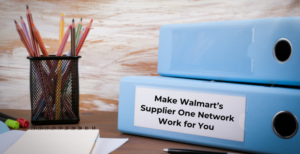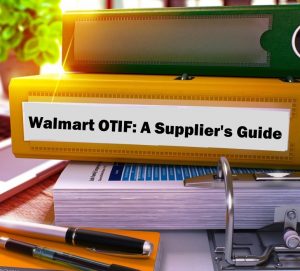Every Walmart initiative supports one goal: Get the customers what they want, when they want it, and at an affordable price. In other words, improving the supply chain will not only keep items in stock but will also lower costs in the end. Walmart programs like On Time In Full (OTIF) work to improve the supply chain process and keep suppliers accountable for details like delivery times and complete orders.
When OTIF proved successful, Walmart began focusing on other details in the supply chain that contribute to a smoother delivery. Requirements like correct purchase order creation, packaging, labeling, and barcode specifications are essential to keep shipments from getting misrouted or stuck in a distribution center.
These accountability measures became known as the Supplier Quality Excellence Program (SQEP), which launched on February 1, 2021. Since this time, 8th & Walton has conducted Walmart SQEP seminars each month to discuss the basics of SQEP, Walmart’s goal, monetary penalties, and what suppliers can do to be successful.
What Is Walmart SQEP?
SQEP is Walmart’s Supplier Quality Excellence Program, designed to drive out unnecessary handling costs in the supply chain. The program focuses on quality of pallets, loads, purchase order accuracy, barcode placement, labeling requirements, and packaging guidelines.
Much like other Walmart programs before it, SQEP helps suppliers become better partners with Walmart. Goals are set and measured, and when suppliers fall short of the goals, there are monetary penalties.
The 4 Phases of Walmart’s SQEP
Walmart launched SQEP in four phases. At the time of this writing, three have been launched.
Phase 1: PO Accuracy and ASN Accountability
Suppliers who are not currently doing ASNs (Advance Ship Notices) should have a conversation with their EDI providers. This is to ensure they are ASN compliant.
In order to stay compliant with PO and ASN expectations, Walmart is specifically looking for:
- Item Setup Information – verifying item information is accurate and complete.
- Parent-Child UPC accuracy – ensuring a child UPC is linked to the parent UPC.
- Canceled Line adherence – suppliers can not ship against a line item after it has been canceled.
- Canceled PO adherence – suppliers can not ship against a purchase order after it has been canceled.
- Overage errors – POs shipped may not exceed the quantity ordered by Walmart.
- Allocation issues – issues involving a sort versus a non-sort or assigned to the wrong store.
- Wrong Pack quantity – the quantity specified on the purchase order does not match the quantity shipped to the Walmart store or distribution center.
- Item Not on PO – item(s) shipped to a Walmart store or distribution center does not match item(s) on the purchase order.
- Recall or Withdrawal shipments – items in the shipment have been recalled or withdrawn.
- Not Walmart Freight – the shipment received by Walmart was not freight intended to be delivered to Walmart.
- No ASN – an ASN label is not located on the case.
- ASN not Downloaded – an ASN was not sent or the ASN could not be downloaded.
- ASN Mismatch – purchase order line where an ASN is present, but ASN quantity and quantity received do not match.
- Imagery issues – for Walmart.com items, incomplete or inaccurate item descriptions.
Phase 2: Labeling and Barcode Accuracy
This phase covered the accuracy of shipping labels. Suppliers also need to verify case labels are scannable and the information is correct.
Under the labeling and bar code umbrella, Walmart is looking for accuracy on:
- Barcode compliance – ensuring all barcodes are correct, in the required format, in the correct quantity, and contain no defects.
- Label compliance – all labels are accounted for with correct descriptions, correct vendor stock numbers, correct item numbers, and contain no defects.
- Hazmat compliance – required hazmat labels are in place and free from obstruction.
Phase 3: Pallet, Load, and Packaging
This portion of the rollout emphasized the basics like box quality, pallet integrity, and load shifts. Walmart is holding suppliers responsible for:
- Load Stability – ensuring loads are palletized, stable, have not shifted, and have no other stability issues.
- Load Segregation – segregation by purchase order type, purchase order item, or other defects.
- Pallet Quality – verifying pallets are compliant with Grade A standards, required size, and free of defects.
- Pallet Securement – ensuring pallets are secured properly, not missing trays, and free of defects.
- Pallet Build – pallet may not overhang, exceed the required height, or contain other build defects.
- Pallet Labeling – pallets must be properly labeled and free of label defects.
- Packaging Compliance – packaging will be checked for weak tape, glue, perforations, poor or loose wrap, unsecured selling units, missing trays, and other packaging defects.
Phase 4: Scheduling and Transportation
As of this publishing, Walmart has not rolled out Phase 4 of SQEP. As details become available, we will update this section.
The SQEP Dashboard for Walmart Suppliers
Anytime Walmart announces a new accountability initiative, a new tool for suppliers follows. In this case, Walmart created an SQEP dashboard. Joel Graham has been working in the dashboard to answer questions for Walmart suppliers about reporting. He believes suppliers will take to the new tool with no problem.
“What’s nice about the SQEP dashboard is the familiarity of the homepage,” Joel explains. “It looks very much like the On Time In Full dashboard that was recently redesigned. There’s a left menu similar to the OTIF dashboard, along with filter and download options. You also have the ability to see specific defects by PO number. Very simple and straightforward to use.”
SQEP Fines for Non-Compliance
As of 2021, the penalty is $200 per defect type + the charge per defect.
Example:
A PO has a “poor quality” pallet defect type and two pallets are flagged.
Charges: $200 + $4 x 2 pallets
Charge for this defect: $208
The same PO has a defect “overhang” defect type and one pallet is flagged.
Charges: $200 + $4 x 1 pallet
Charge for this defect: $204
Total SQEP charge for this PO: $412
Fines can add up fairly quickly when you consider that some POs can have hundreds of cases on them. Now’s the time to work with your item file and confirm the accuracy of all the data being shipped through Walmart.
How to Reduce or Eliminate SQEP Penalties
To get ahead of the program, or to eliminate penalties you already foresee, there are easy steps to take.
1. Check Your Current Labels
Walmart suppliers should take a few minutes to verify the accuracy of what they’re shipping.
- Check your case label and check your shipping label for 100% compliance.
- Walk out to your warehouse, get a copy of a label that goes on a case, and compare it to what is in the Walmart packaging and labeling guide.
- Grab a shipping label and go element by element to make sure it matches what’s in the shipping guide.
2. Attend the Next Seminar
Our Walmart advisors stay on top of new communications and any updates to SQEP. New content is added to our SQEP seminars that suppliers can attend each month live via Zoom. For dates and information on our next SQEP seminar, click here to reserve your spot today.
3. Get One-On-One Help From Walmart Experts
Can’t attend a seminar, but want to ask a question? Our Walmart experts are happy to help! Book a free 15-minute consultation with a Walmart expert.
Complete the form below to schedule your free consultation.
Conclusion
Walmart is always working to deliver better products and services to its customers. To keep costs down and keep the shelves full, programs like SQEP are developed to enhance supply chain accuracy.
Is your team trying to improve your supply chain performance? Our team can help. Whether you need help with SQEP, OTIF, or assistance with Walmart’s scorecards and performance tools, a free consultation is the beginning of setting your team up for success. Request a meeting with our advisors to get started!



